In 1812, Moscow was in flames. As the French Revolution caused a sociological shock-wave that reverberated across Europe, the threat of change was ever present in European society. The sheer magnitude of destruction in Moscow had never been seen before as French troops reduced the city to rubble. Although this was a horrifying event, Tolstoy’s ‘War and Peace’ gives an interesting account of the citizens involved. The institutions and monuments are razed but the people still carry the identity of the city. The death of the institution leads the common man to change history. The spectacle of the ruin incites a change in view; the idea of the individual. Modernism itself was a product of this destruction and upheaval, which was happening all across Europe. Ruins are inexplicably linked to deep societal change.
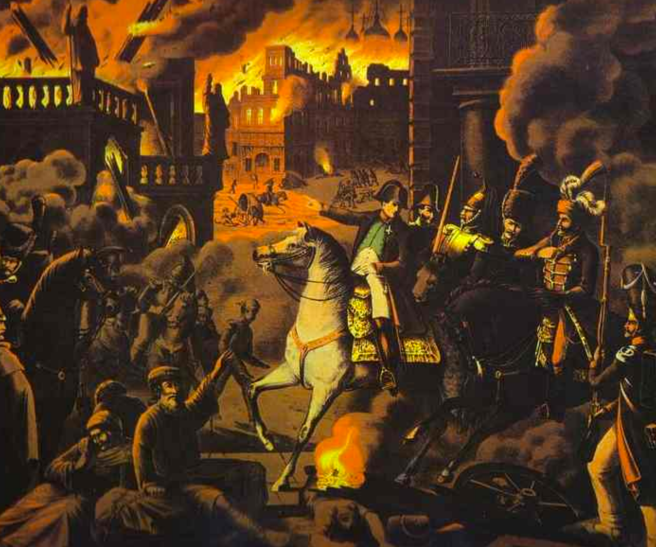
Moscow in flames
Although the modern reader still may see some melancholy relevance in the Romantic poems of Byron, Shelley and Keats, the attitude towards ruin has changed drastically. This fascination is not merely neo-Romanticism, but a renewed and entirely new obsession with ruination. There is a proliferation of websites dedicated to ruins and ‘urban exploring’ itself is no longer just a past time among artists, but thousands of hobbyists. The contemporary fascination with disaster films is also a signal of an obsessed culture.
Looking for a start to this obsession, Romanticism itself can be seen as a product of the French Revolution. In Romanticism, ruins are part of the expression of the sublime, a quality of greatness based upon both beauty and fear. However, the ruin is not only an object of aesthetic pleasure, it is also foundation for an alternative present and prospective future. Ruins inspire hope and fear as they suggest that new revolutions will topple even the greatest of empires. The Roman general, Scipio was said to have wept when he ordered Carthage burnt to the ground as he realised that one day this would be the fate of Rome itself.
The sociologist Georg Simmel spoke of the ‘equalising justice’ of the ruin, the leveling of hierarchies in the aesthetic space. In Romanticism, ruins represent the ancient tower of Babel motif, the toppling of greatness. Hitler’s architect Albert Speer was tasked to build a Germany that would make a beautiful ruin akin to Rome, anticipating it’s eventual doom.
Although Romanticism was intertwined with ruins, they were also perceived as incredibly distant. Shelley’s ‘Ozymandias’ takes place in an ‘antique land’ in a desert; presumably far away from Victorian London, signalling perhaps their apparent comfort; their civilisation isn’t going to fall just yet.
Although we can still look at the same ruins the Romantics did and have a melancholy interest in the past, our concept of the historical ruin has changed dramatically. Contemporary ruin-gazers will see the ruin as a remnant from a certain era as a way of understanding the history of the object. However, the Romantics viewed the ruin purely as a metaphor for ‘the past’ without a contextualizing time frame. The horrors of human history are now understood as a result of a specific disaster rather than the abstract notion of time as a destroyer. It is seen here in the ‘Ocean’ section of Byron’s ‘Childe Harold’s Pilgrimage’, Canto IV
Thy shores are empires, changed in all save thee
Assyria, Greece, Rome, Carthage, what are they? 1
Four doomed civilisations are presented in the space of one line, bringing them all into the same time frame. Byron’s description of the ocean as a timeless force also introduces the Romantic concept of the struggle between man and nature.
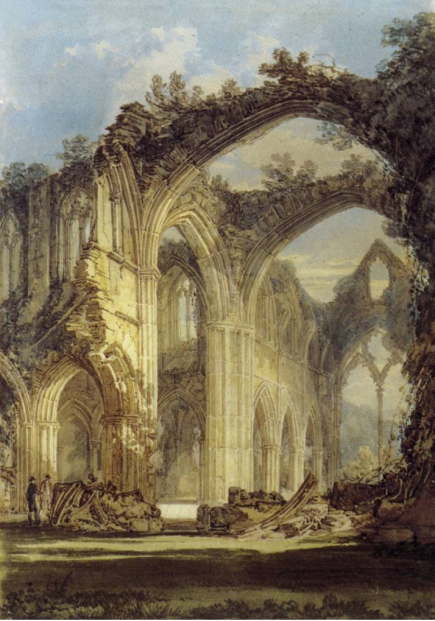
The Chancel and Crossing of Tintern Abbey, Looking towards the East Window by J.M.W Turner, 1794
Although the ruin may capture the contemporary imagination, the artist today is unable to ruin gaze as the Romantics did. Many poets used Tintern Abbey, a ruined Cistercian monastery as a source of inspiration. For Tennyson or Wordsworth to visit would involve finding a local to ferry them down the river as it was inaccessible by road. The ruins would have been covered in ivy and sprouting trees, a key facet of Romanticism symbolic of the struggle between man and nature. The poet would have perceived himself as an explorer uncovering a lost civilization. In a time where we are all connected with such ease, are ruins as special?
Today, the abbey is carefully manicured by Cadw, Wales’ historical trust fund; therefore unable to progress further into ruin. The contemporary visitor would also be required to pay an entrance fee and become overrun by information regarding the historical context of the ruin, something the Romantics were not particularly interested in. The Romantics saw melancholy in the forgotten site, which is now but now it is a facet of the capitalist tourist trade. The Romantic ruin-gazer’s image would be fleeting and ephemeral. One search on the Internet allows me to view thousands upon thousands of images of the ruin. Piranesi, famous for his sprawling, ruinous etchings, would not recognize the streets of Rome today, filled with tourists with cameras, capturing what has been captured countless times before them.
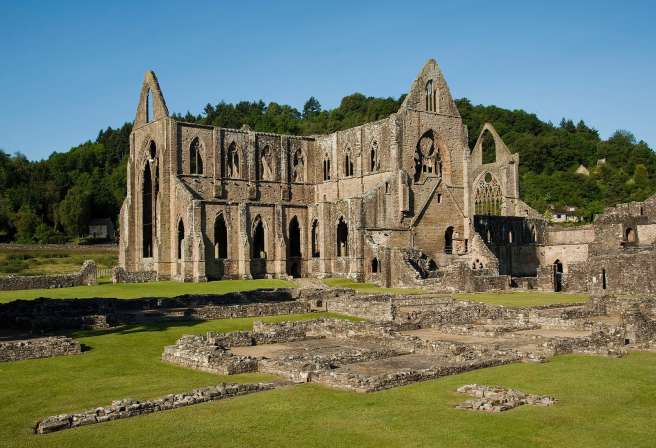 Tintern Abbey today, sans vegetation
Tintern Abbey today, sans vegetation
Ruins Today
“The grey film of dust covering things has become their best part” – Walter Benjamin 2
Although ruins are inexplicably linked to violent destruction, the death of modernism has bought about a new type of ruin. As the start of modern thinking was brought on by the carnage in the wake of the French revolution, the end of modernism was heralded by a different kind destruction.
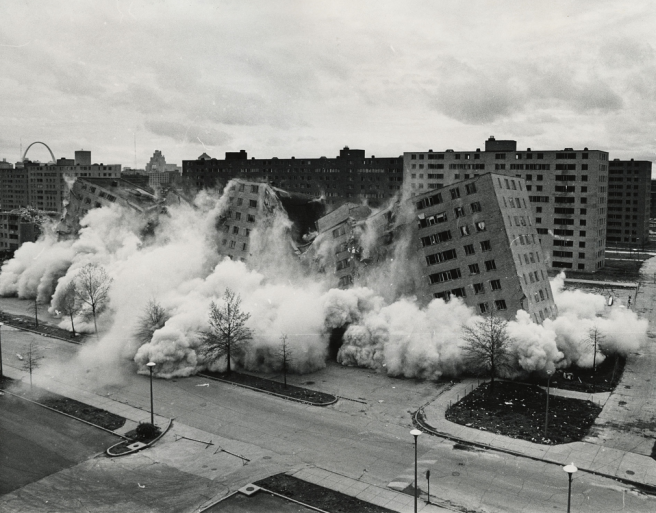 The destruction of the Pruitt-Igoe complex
The destruction of the Pruitt-Igoe complex
The demolition of the failed Pruitt-Igoe social housing complex, as featured in Godfrey Reggio’s ‘Koyaanisqatsi’ heralded the end of modernity. The American dream of continuous prosperity had ended. The ruination that followed was nothing like Scipio’s sacking of Carthage, but a particular apathy and loss of hope and wealth. Through historicising, it could be said that modernism was a time of potential ruin. The German poet and philosopher Friedrich Schlegel noted,
“Many of the works of the Ancients have become fragments. Many of the Moderns are fragments the moment they come into being.” 3
He suggests that as the world transitioned into modernism, the pace of time sped up drastically. Once a building could have stood for millennia, such as the ancient ruins of Rome, now it can be pulled down and rebuilt in the space of a couple of years. Despite this proliferation of the modernist ruin, Walter Benjamin asserts in his 1927 essay ‘Dreamkitsch’ that the romantic notion of dreaming had faded and lost its aura, meaning we would be unable to dream as the Romantics did. This suggests that as ruins are so immediate to us, we cannot perceive them as romantic metaphors. So how do we perceive our modern ruins?
Modern Ruin Gazing
Slivers of sullied white cloth heave like tattered sails in the wind. Water pours through the levels of seating and sprouts greenery like a post-modernist garden of Babylon. Detroit’s Pontiac Silverdome, with a capacity of 82,000, has been abandoned since 2006.
With the image of the grand stadium reduced to a shell, the viewer cannot help but draw immediate comparisons to the Silverdome and the Coliseum. The Coliseum was ruined by the fall of civilisation, an instant of violence, whereas the Silverdome’s downfall was much slower as was abandoned and left to the elements. They are two entirely different sets of ruins.
Detroit’s ruination was the result of the so called ‘white-flight’, an exodus of more than a million people into the suburbs, leaving the city center a husk of dilapidated buildings. The most impressive structures such as the Silverdome and Michigan Central Depot exude a sense of dilapidated wonder, but the majority of ruins are private home, office blocks and hospitals; nothing like the temples of Rome or Athens. Interestingly, these domestic ruins are the main focus of modern ruin-gazer, the ‘urban explorer’. George Steinmetz claims that this attention to the familiar is mainly a ‘simple nostalgia for Fordism, a desire to relive the past’. Once Detroit was a wealthy metropolis, built on the motor industry, a product of modernism itself. Upon the collapse of modernism, the decay of the city was said to fire the popular imagination as it was mourning the loss of prosperity. The ‘DetroitUrbex’ collective’s website is an extensive archive of the city’s many ruins, the beauty and the sheer quantity of these images suggest something more than a bourgeoisie yearning for past wealth, they speak of a profound loss of culture and community.
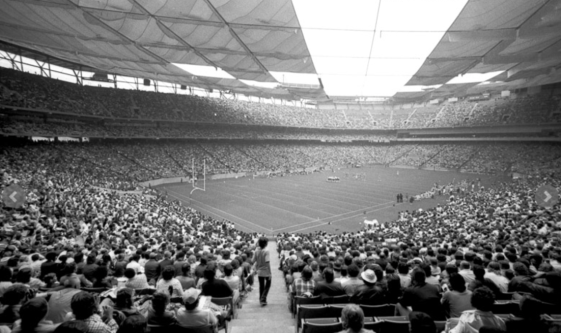
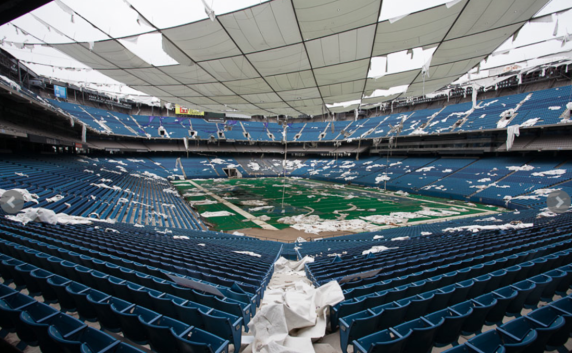 The Silverdome in 1975 and 2013
The Silverdome in 1975 and 2013
If we compare this to the destruction Tolstoy’s Moscow, there is a major difference. Moscow was rebuilt with a new societal outlook, as the city was the citizens itself. Detroit’s citizens had invested interest in the suburbs instead, an acquiescence and fragmentation common in post-modernist thought, shattering communities in the process. Many photographs in the DetroitUrbex archive depict public spaces such as theatres where the viewer can easily imagine them new, loved and full of crowds alongside their present form.
In an effort to ward off inevitable decay, city planners demolished vast swathes of housing. Instead of clearing the ruin, they instead produced a kind of ‘anti-ruin’, the ghost-like negative of a ruin that suggests that the city can rid itself of the physical decay but ruination exists on a higher cultural level.
There has been a certain shift in interest; contemporary ruin lust targets the modern ruin rather than the ancient. These are site many may have remembered being in use. Perhaps this is due to a more environmentalist attitude, a post-modernist concern, to the irreversibly of the past that the romantics focused on. Instead of gazing at etchings of Roman ruins to imagine our potential doom, the prevalence of science fiction reminds us that all civilisations must fall. This has an added hint of realism with the constant, looming threat of environmental disaster, global warming and all-out nuclear war.
Ruinous Futures
“No one can win against kipple…” – J. R. Isidore 4
In sci-fi writer Philip K Dick’s ‘Do Androids Dream of Electric Sheep’, Isidore, a lone inhabitant of an abandoned apartment building, uses the word ‘kipple’ to describe accumulating waste;
“Kipple is useless objects, like junk mail or match folders after you use the last match … When nobody’s around, kipple reproduces itself. For if you go to bed leaving any kipple around your apartment, when you wake up the next morning there’s twice as much of it. 5
George Bataille’s document, ‘Dust’ considers the growing excess of dust and ruin on contemporary culture obsessed with rapid change and growth. Similarly in this novel, the proliferation of disposable consumerist culture has culminated in a future full of material ruin we are unable to rid ourselves of. In Androids, in fact, the entire earth is a metaphorical ruin as most of the population have left to ‘off world colonies’ to escape from the collapse that they have contributed to, a metaphor for the reckless capitalist gain in America at the beginning of the 1950s. It also highlights the struggle between man, nature and architecture; in this particular future, man seems to be losing.
As the French Revolution threatened social structure in Tolstoy’s War and Peace, Dick wrote Androids shortly after the Cuban Missile Crisis, which threatened nuclear destruction, a power the world had not previously encountered. The world saw itself so close to destruction that since then culture has become both terrified and obsessed with imminent disaster. As with the Romantic’s love for the ruin’s potential future, popular culture is crowded with speculative sci-fi and disaster films, which show us a glimpse of our end.
The film adaptation of Androids, Ridley Scott’s ‘Bladerunner’ shows us this ruinous future. Breaking away from the early sci-fi cliché of the perfect utopian city, we are shown the direct failure the Le Corbusier style urban planning and the Wellsian vision of a faultless future. Instead, Bladerunner speaks of a retrofitted future built on the wreckage and ruin of the past. The opening shot of the film is of a sprawling city-scape that the viewer can envision to stretch out to infinity, way beyond the frame of the lens, like the cavernous ruins imagined by Piranesi. With no more room to build outward, the city is built ever upwards on top of the detritus below. The opening title card reads ‘Los Angeles, 2019’; 30 years from the release date, a familiar setting and a very close vision of the future.
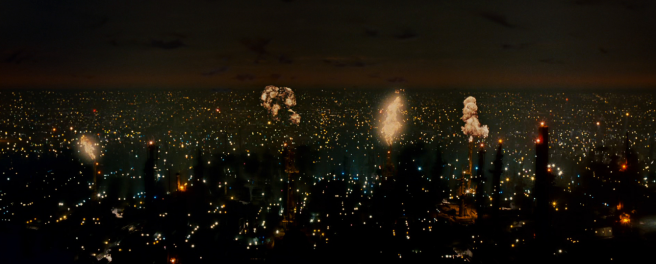 Bladerunner’s opening sequence
Bladerunner’s opening sequence
One of the most interesting aspects of the film regarding ruins is the final scene, which take place in a real building, the ‘Bradbury Building’, a late Victorian warehouse that is a recognisable part of the contemporary Los Angeles cityscape. This connection inexplicably links present, past and future. The building is also seen abandoned and in ruins, which is reminiscent of the Romantic ruin-gazers metaphor for the ruin as potential future.
The ‘Altermodern’
The destruction of the World Trade Centre in 2001 is argued to have signaled the end of the post-modern era and entered the world into a new phase of ruination. Nicholas Bourriaud refers to this as the, ‘Altermodern’. He tells us of our ‘fast burn culture,’ in which we are ‘worshipers of the rapid liberation of a massive quantity of energy’. The very pace of life precipitates both rapid construction and destruction. 9/11 was a direct threat to a previously secure regime. Since then, apocalyptic ruin imagery can be said to have taken over American imagination and trickled down into popular culture in the form of disaster films and zombie epics. From the Romantic point of view, this could have signaled the start of the toppling of a mighty empire.
In regards to a post-modernist landscape, Derrida also remarks that
“Ruin is that which happens to the image from the moment of first gaze”.
In the age consumerism and reproduction, the very notion of the image is a ruin, which the public is continuously bombarded with. The ruin is no longer the figure in the desert of a far away land like Shelley’s ‘Ozymandias’, it is present in our culture itself and we, as a culture, are afraid of cultural collapse.
Despite this, physical ruins are now endangered species. In cities of great capitalist strongholds, abandoned buildings are quickly transformed or replaced. The Internet, the very symbol of the post-modern age itself does not allow decay. A webpage from 1996 may be accessed today and though the design may be out-dated, there is no sign of Bataille’s dust. The disappearance of ruins from our peripheral vision no longer allows us to engage in a Simmel-esque, romantic contemplation of the past and prospective future. The Romantic notion of the isomorphism between nature, architecture and the human body is gone. We can no longer even imagine the romantic notion of the ruin as the gardens we see that surround the ruins of the past are not sprawling and sublime, they are but a simulacrum of nature, trimmed to perfection. Guy Debord’s prophesied Spectacle culture does not allow us to stop and think at all as the government and corporations push forward with redevelopments. The true ruins of today are the building sites that eat away at the cores of our cities. City dwellers are confronted with endless construction, reconstruction and removal as inhabitants are pushed further into the outskirts.
In the contemporary city, the continuous stream of half-built office blocks and skyscrapers are ruinous, bearing their husks to the open sky. We can no longer be redeemed by the burning of a city such as Tolstoy’s account of Moscow as ruination has seeped into society itself. The urban explorer, the reincarnation of the ruin-gazer, fulfills the same purpose. In an uncertain time, such as today, perhaps on the brink of societal change; the urban explorer sees both the doomed prospective future and years nostalgically for their modernist past.

